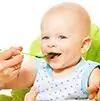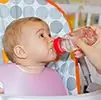Feeding a baby at 1 year
Feeding a one-year-old child must be based on his age. On the one hand, the baby has already grown up well enough, and can eat many new dishes. But it is extremely important to make sure that his food is both healthy and safe.
Products for feeding a baby at 1 year old

It is impossible to abruptly transfer the baby to a new diet, and even more so to "adult" food. If it is not possible to prepare food specifically for the child, then you can continue to use ready-made baby food in jars. For feeding a baby at 1 year old, such products have a suitable consistency with rather large pieces for the development of chewing skills.
After a year, there is no need to sharply reduce the share of dairy products, since their volume in the first year (breast milk, formula) was quite large. It is recommended to include up to 500-600 ml of milk and lactic acid products (including in casserole, porridge) in the annual diet every day. They are a valuable source of easily digestible calcium, phosphorus and protein, which is extremely important for a growing body.
Among lactic acid products, special attention should be paid to specialized children's fermented milk products - curds, kefir. For feeding a baby at 1 year old, the so-called "follow-up" adapted milk formulas of the third stage have been created. They satisfy the needs of a child over a year old for the nutrients he needs, without causing allergies, such mixtures are preferable for the baby than ordinary cow's milk.
If the mother still has milk, she can continue breastfeeding if she wishes. As the baby grows, the composition of breast milk also changes; it remains an important source of proteins and immunoglobulins.
Little by little, it is worth expanding the menu with curd-vegetable and curd-cereal casseroles. After a year, children are already given some hard cheese of mild varieties, if they still do not chew very well, the cheese can be grated.
An obligatory morning dish should be porridge made from any cereal - buckwheat, rice, oats, wheat, corn. But pea and millet porridge at this age is still too rough for the baby's delicate stomach. Porridge can be cooked in milk, formula, or water and seasoned with a little butter.
To feed a child at 1 year old, bread should be served with the first and second courses - first wheat, since it is more easily absorbed by the digestive system, and then rye. You should not teach your child to eat pasta immediately after he turns one year old. He, of course, will appreciate and love them, but the nutritional value of pasta is low, since it is a source of "fast" carbohydrates, and there are very few nutrients and fiber in them.
Both in summer and in autumn, vegetables and fruits must be present on the table - fresh, baked or boiled. If the child does not chew well, you can grate them, rub them through a sieve, grind them with a blender or in a meat grinder. Vegetable soups, casseroles and mashed potatoes are also recommended.
Children's ready-made vegetable and fruit purees can also be an alternative to your own herbal products. They are especially convenient on the road or at a party, when you are not sure that the food will be suitable for the baby at the table.
It is advisable to continue to give vegetables and fruits only those that grow in your area. In the middle lane, these are most often apples, pears and plums. Exotic fruits can trigger allergic reactions. From fruits and berries it is good to prepare fruit drinks, compotes, jelly, juices for the baby.
Meat for feeding a one-year-old child is most often not a new product. The child has been eating it for 4-5 months at lunch time. Meat is a valuable source of protein, B vitamins and iron salts. Of the preferred varieties of meat, it should be mentioned as especially valuable - turkey, rabbit, lean pork, chicken, veal, beef.
From a year old, it is advisable to give meat not just in the form of mashed potatoes, but in meatballs and steamed cutlets, so that the child gets used to chewing. By-products - liver, lung, or chicken stomachs - are still too rough for his digestive system. With the addition of meat for a one-year-old baby, you need to cook vegetable and cereal soups.
Meat can be replaced 2-3 times a week with a fish dish as a valuable source of iodine, phosphorus, vitamins and protein. Preference should be given to cod, pollock, pike perch. Red and river fish for a child is a potential allergen. Fish is used for steaming fish cakes or soup.
All foods used to prepare meals for young children must be known to be safe and fresh.
Diet

Meals are recommended to be timed to a certain time - this is useful both for the formation of digestive juices before meals, and in terms of the child's subsequent adaptation to nutrition in the family and kindergarten.
The baby's feeding intervals become longer after a year, with the optimal option of five feeding times they are 3.5-4 hours.
Approximate feeding schedule for a child at 1 year:
- First breakfast - breast milk, formula or cow's milk;
- Breakfast - porridge, juice;
- Lunch - soup, meat dish or fish, side dish (vegetables or cereals), a slice of bread;
- Afternoon snack - your choice - fruit puree, pudding, cottage cheese or kefir with cookies;
- Dinner - vegetables or cereal, formula, or breast milk.
It is advisable not to shift the baby's feeding intervals upwards. If it is not possible to feed the baby in time, then in this case it is necessary to take food with you for a light snack. Between main feedings, you can offer your baby unsweetened biscuits or crackers, peeled pieces of vegetables or fruits as a snack. You should not form a negative habit and offer him sweets for this purpose.
Found a mistake in the text? Select it and press Ctrl + Enter.







